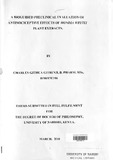A bioguided preclinical evaluation of Antinociceptive effects of Mondia Whytei plant extracts

View/
Date
2010Author
Githinji, Charles Githua
Type
ThesisLanguage
en_USMetadata
Show full item recordAbstract
Mondia whytei is a forest floor plant with aromatic rhizomatous roots. It belongs to the Asclepiadaceous family. In this study, the antinociceptive activities of various parts of this plant were evaluated and investigated with the aim of isolating the active compounds in a bioguided manner. Mechanisms of action of the isolated compounds were also elucidated. Soxhlet extraction of the leaves, barks and roots powder of Mondia whytei using water, ethanol and chloroform were carried out. Acetic acid induced writhing tests on Swiss albino mice were carried out on each extract. Acetic acid induced writhing test is simple to perform, reproducible and sensitive to antinociceptive effects of various drugs. It was therefore chosen as a screening test. The chloroform root (CR) extract showed the most potent antinociceptive activity with an IDso of 198.8 mg/kg body weight.
The root powder was defatted using n-hexane and the marc extracted with chloroform and methanol successively. The defatted chloroform root extract (CRI) was found to have reduced antinociceptive activity with an IDso of 350 mg/kg body weight. This is a 76% reduction in antinociceptive effects compared to the CR. Another defatted root powder was extracted with methanol only and then partitioned with chloroform. The chloroform soluble portion ·(CrM~) showed an increased antinociceptive activity with an ID50 of 50 mg/kg body weight. This is a 75% increase in antinociceptive effects compared to the CR. CfMRd was fractionated with 30% methanol in dichloromethane and TLC carried out. Five fractions were obtained as follows: CfMRd I with Rf = 0.71, CfMRd II with Rf = 0.48, CfMRd III with Rf= 0.37, CfMRd IV with Rf = 0.18 and CfMRd V with Rf = 0.1.
The five fractions were each subjected to writhing test at a fixed dose of 10 mg/kg, CfMRd I showed 29.7% inhibition, CfMRd II; 6.5% CfMRd, III; 5.4%, CfMRd IV; 1.7% and CfMRd V; 2.9%. A dose response curve gave an ID50 of 14.8 mg/kg and 28.6 mg/kg body weight for CfMRd I and CfMRd II respectively. White crystals of CfMRd I were obtained at room temperature with a melting point of 168 °c whereas CfMRd II crystals were off-white at room temperature with a melting point of 79 DC. GC-MS analysis of CfMRd I showed a prominent molecular ion peak at m/z 412.4, empirical formula C29 H48 0, with a fragmentation pattern characteristic for sterols. It was confirmed by National Institute of Standards and Technology (NIST 05a) spectral library as a stigmasterol. CfMRd II showed a prominent molecular ion peak at m/z 364.0, empirical formula C26 H52, and confirmed as 9-hexacosene. The antinociceptive effects of stigmasterol and 9-hexacosene were tested using formalin test in mice. Formalin test was used since it is a superior antinociceptive test in several aspects compared to the other anti nociceptive tests.
The pain stimulus bears resemblance to most clinical pain and the two phases observed in the test may represent different types of pain, acute and chronic pain respectively. Stigmasterol reduced the time spent licking, biting and/or lifting the injected paw in both the early phase (Neurogenic pain) and the late phase (Inflammatory pain) of formalin test. This reduction was found to be dose dependent and was statistically (p<O.OOI) significant at a dose of 30 mg/kg body weight and above. No motor, neurological, or other behavioral deficits were observed. 9-hexacosene produced dose-dependent and statistically (p<O.OOI) significant antinociceptive effects on the late phase only and at a dose of 7.5 mg/kg body weight and above. The dose of 100 mg/kg body weight was equipotent to indomethacine dose of 50 mg/kg body weight (Scheff'e post hoc test for multiple comparisons). No motor, neurological, or other behavioral deficits were observed.
Stigmasterol had both centrally and peripherally mediated antinociceptive effects whereas 9-hexacosene had only peripherally mediated antinociceptive effects. Stigmasterol and 9-hexacosene were isolated for the first time from Mondia whytei. They were shown to be the compounds strongly involved in the antinociceptive effects of Mondia whytei roots. This study authenticates the use of Mondia whytei in the management of pain since it contains stigmasterol and 9-hexacosene which have shown significant antinociceptive properties.
KeyWords:
Antinociception, Mondia whytei, stigmasterol, 9-hexacosene
Publisher
University of Nairobi, Kenya
